Memes have become a unit of cultural currency in the digital age and can be found across all social media platforms. They are humorous pieces of content, often featuring an image and text, intended for quick consumption. But can you use memes for marketing? This article looks at what memes are, how you can use memes for marketing, and what to watch out for if you do try out this strategy.
What are memes?
The evolutionary biologist Richard Dawkins coined the term “meme” in his 1976 book, The Selfish Gene. The word is a combination of the Greek “mimeme” (something imitated) and “gene”, pronounced to rhyme with “cream”.
In Dawkins’ definition, memes are contained in how, “our ideas, ideals, cultures, and customs replicate themselves. Almost like a virus, they travel from person to person through imitation, sharing, and repetition.”
Dawkins proposed that memes are found in the animal kingdom too, suggesting that they have some evolutionary benefit. We are all wired to pass on the memes that serve a purpose. The memes that are not worth sharing quickly die out. A University of Vermont study even found that contagious diseases follow similar transmission patterns to internet memes.
The social networks of today are perfect for transmitting these cultural genes. If a post strikes a chord with the audience, it can go global almost instantly. The most successful memes tend to capture a moment, a thought, or feeling in a visual, social media-friendly format.
This timeliness does not have to exist within the original meme; it can be added by the user, through new text, or by using it in a new context. Take the classic “distracted boyfriend”, for example. You can’t claim to have never seen this image - which first appeared online in 2015 - used in some form.

Richard Dawkins has confirmed in an interview with Wired that internet memes are similar to what he envisioned, saying, “It's anything that goes viral.” As such, anything can be a meme; Dawkins himself has been given the meme treatment on many occasions.
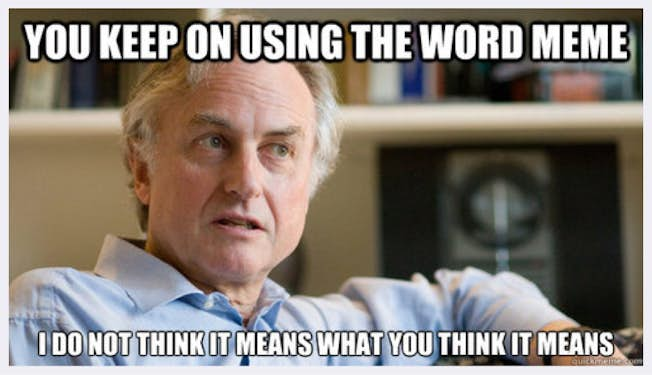
The blog Pocket-Lint has collated the most famous memes of all time in this list, including the ‘Doge’ meme:
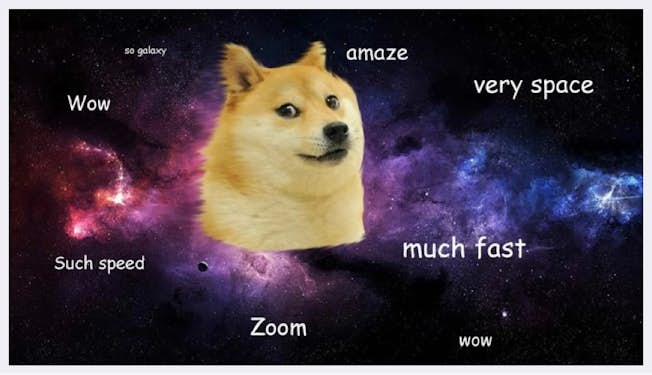
This meme started on Reddit, where users photoshopped cute pictures of Shiba Inu dogs onto different backgrounds. The dog’s curious expression creates a humorous juxtaposition with his new surroundings.
The meme spawned a satirical cryptocurrency, Dogecoin, which was later supported by Elon Musk and now acts as a shirt sponsor for Premier League soccer club Watford FC. This trajectory is crucial to the lifespan of internet memes; they are transmissible, but they are also infinitely adaptable and they take on a life of their own.
Another new form of currency where memes are showing their value is non-fungible tokens (NFT). The woman whose image as a 4-year old in front of a burning building spawned the “disaster girl” meme, recently reaped a half million dollars in selling it as an NFT, using the proceeds to pay off her loans and donate to charities.

So, memes are a cultural phenomenon that looks set to stay with us for some time. Does that mean brands should use memes for marketing?
The benefits of using memes for marketing
1. Memes are cheap to create
There is a certain homespun charm to internet memes. Anyone can get involved, using sites like Meme Generator to add text to the classics of the genre.
Brands can use memes created by other people for their marketing campaigns, but it is advisable to create your own memes if you plan to use them for marketing purposes. Marketers have to work a little harder to jump onto cultural trends.
The hard part is thinking up a witty caption. This example from BarkBox provides a handy reference point:
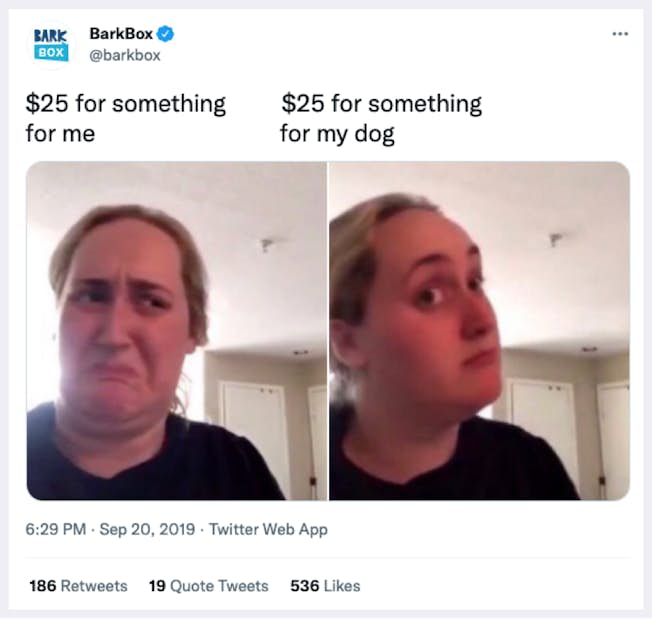
It is relevant to the brand and relevant to the audience, without destroying the connection with a pushy sales message.
When executed with skill, memes are a cheap and cheerful way to attract social media interaction.
2. Memes can be a powerful brand marketing medium
You can also create meme-able content yourself. That is to say, brands can create content that has the potential to become a meme in its own right.
For example, when Netflix released preview material (for example, the image below) for its Bird Box series it provided the canvas for countless memes:

Netflix released images such as this to intrigue viewers about the upcoming show, but they also wanted to encourage engagement. People started using the image in new contexts, from the banal to the absurd.
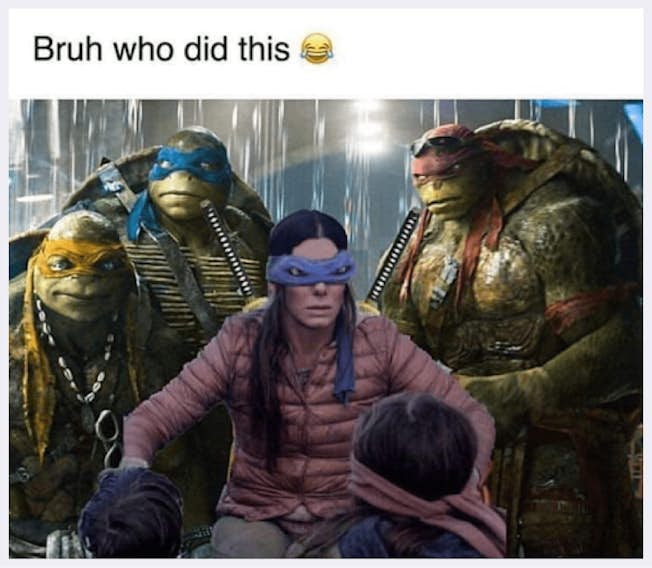
The reviews for Bird Box were not particularly kind. Salon’s Melanic McFarland wrote “Is it good? Not really, but it doesn’t need to be.” Due to what we might call the “meme effect”, people watched Bird Box anyway - it had 45 million views in the 7 days after its launch.
Netflix even had to warn people not to try blindfolded stunts in an attempt to recreate the memes.
More recently, Netflix’s breakout hit Squid Game has led to countless new memes, many of which - as befits the form, and powers Netflix’s ratings - are understandable only to those who have seen the show. Brands have been quick to get in on the action, too. Pepsi has attracted over 37,000 likes already for this Instagram image of a highly-symbolic Squid Game visual reference (no spoilers!) in one of its drinks, with the caption “if you know you know”.
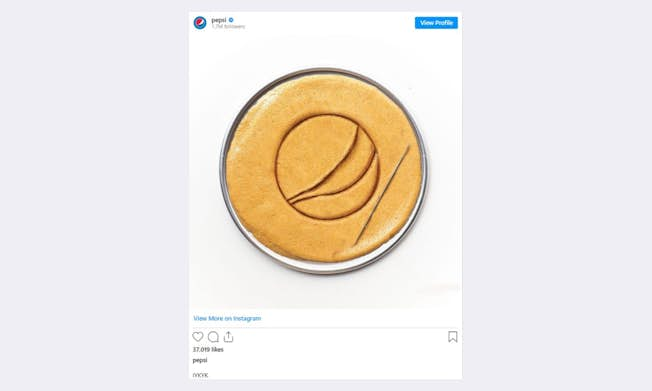
It is important for marketers to embrace the spirit of a trend like the Squid Game craze if they want to use it as a vehicle for brand messaging. The Pepsi example is playful and the caption “If You Know You Know” gives a suggestive nod to fellow fans of the show.
A company like Netflix has a native advantage, with its content factory and Hollywood stars. Yet memes do not need this level of gloss to appeal to a mass audience.
For example, this image from Chipotle has plenty of meme potential:

The more widely it is shared, the more people will see the brand. And the best memes hang around for years, too.
3. Memes can show a human side to your company
When businesses use memes, they inevitably show their human side. That can mean poking gentle fun at the brand’s traditional ways, as in this image from Denny’s:

Denny’s jumped on the ‘10-year challenge’ started by Facebook, which was already a viral phenomenon. It did not try to hijack the trend for its own ends but rather joined in the fun with a different take on the meme format.
A 2017 study into complex contagion models online - which accurately predicted the duration of the ALS Ice bucket Challenge - found that when people see a meme that reflects their current mood they feel ‘seen’. As a result, they share the meme in the hope of finding social validation from other social media users.
That means that memes do not always need to be funny. They can be thought-provoking and insightful, not just seen as frivolous. It is safer for brands to start with the lighter memes, however, as the more serious images tend to be political in nature. Denny’s provides a handy blueprint here; brands fare best when they show some self-awareness.
4. Memes generate instant feedback
Memes are appealing to marketers, for all of the above reasons. Their reason for existence is to go viral and that is what every brand has talked about since the advent of social media.
There are no guarantees on this front and most memes will die out quickly. But brands should see this as a learning opportunity, not a reason to forego memes. As long as the meme attempt is not disastrous (we’ll have examples of those later), marketers can use memes to generate instant feedback from their audience.
If it’s fitting for your brand, it is worth taking a shot at creating a meme. They are cheap to produce and tend to fade away promptly if they do not take off. And if they do go viral, you may just find that you tapped into something you never knew about your audience.
This meme from Running World shows great awareness of its fans, making fun of their passion rather gently:
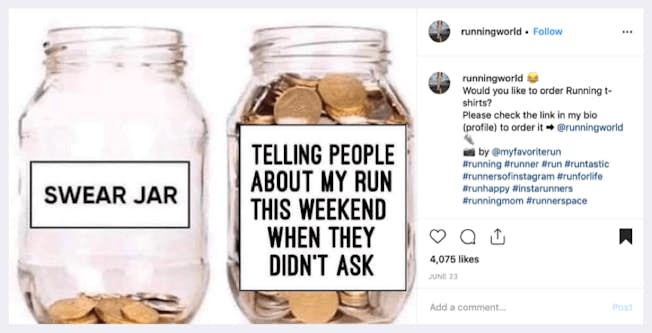
The Runner’s World meme fosters a sense of community, essentially making an “in-joke” that only runners (and their friends) would truly get.
This approach may not have worked so well if the audience did not get the joke, but little damage would be done in the process of trying it out.
That said, brands do need to be careful. This example from potato chip brand Ruffles has gone down in social media folklore as an example of how not to do it:
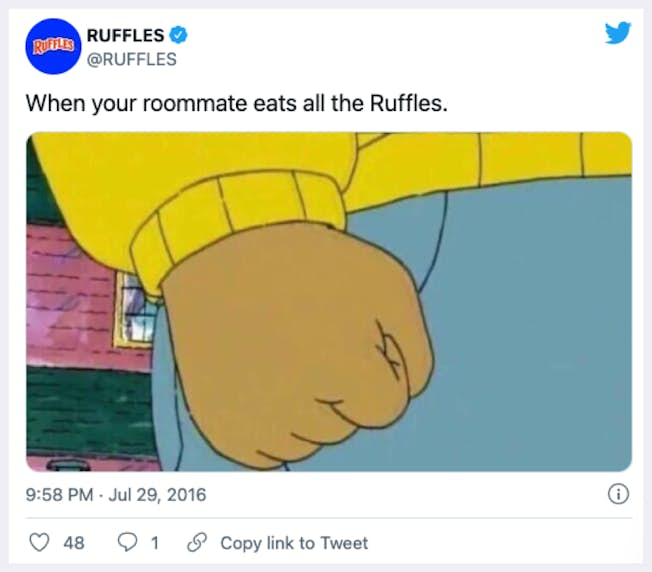
It is too focused on the brand, doesn’t provide any reason for the user to share, and uses a format that has already been seen too many times. Each time someone picks up a meme to use, they need to add something new to the existing catalog.
It’s also worth learning about the cultural (and political) meaning of memes can change over time, as illustrated in this documentary about how Pepe the Frog morphed from an innocent amphibian to a divisive symbol.
By observing the core principles of meme marketing, brands can avoid these pitfalls.
Should you use memes for marketing?

Brands must be aware that memes will only help meet some marketing objectives. If they push a sales message, users will be put off immediately. This brings similar considerations as in our marketer’s guide to Reddit. The key is to understand the pulse of the audience and join in, adding something that contributes to the moment. Brands that get it wrong detract from the mood and pay the price.
However, memes can form part of a serious strategy. Keep these tips in mind as you add memes to your marketing plan:
- Keep up to speed with pop culture: It is vital you keep pace with current trends; timeliness is the lifeblood of the viral meme.
- Show some self-awareness: If you are hoping to push a brand message, use humor to deflect and to show a human side.
- Find the right channel: Memes are everywhere, from Snapchat to LinkedIn, but they differ in format and tone by channel. TikTok memes tend to use music as an extra element, for example.
- Use a tone that fits the brand: It is important to stay professional, even when joining in on a social media challenge. Customers expect the brand to act in line with its traditional identity.
- Research your audience’s preferences: Use social media advertising tools to identify these cultural preferences before launching a meme strategy.
- Get involved with trends and challenges: Since these are already viral, they provide guaranteed visibility. Just make sure to use that currency wisely.
- Create a meme library: The same memes pop up all the time and their familiarity is comforting. Keep a meme library and adapt the text quickly when an idea strikes.
- And check the licensing of images: A rather dull point to close on, but an important one. If you are gathering images to create new memes, do check for any licensing considerations.
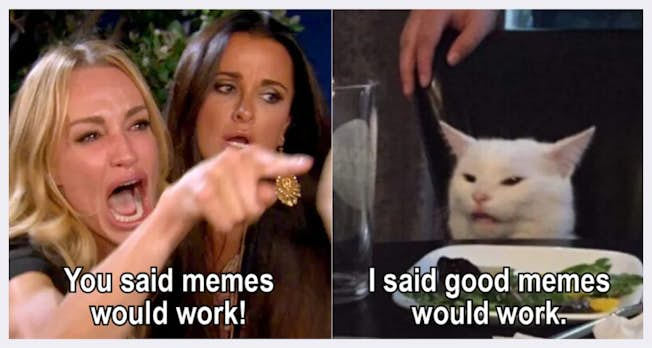
Related
Upgrade to Power Membership to continue
your access to thousands of articles, toolkits, podcasts, lessons and much much more.
Become a Power Member- Login
- View Courses
- - - -
- Courses
- Resources
- - - -
- My Account
- Change Password
- Logout





